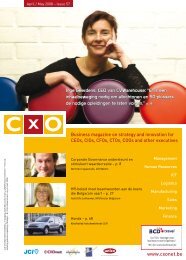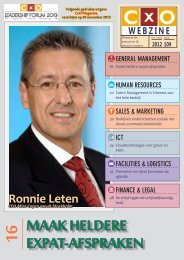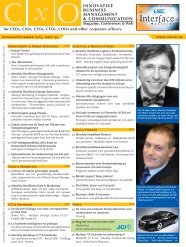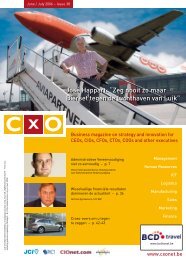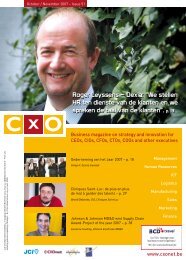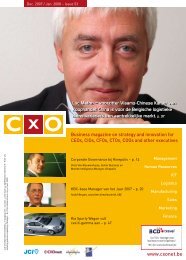Patrick Lips – AA Gent: “Emotie is een slechte raadgever in ... - CxO
Patrick Lips – AA Gent: “Emotie is een slechte raadgever in ... - CxO
Patrick Lips – AA Gent: “Emotie is een slechte raadgever in ... - CxO
Create successful ePaper yourself
Turn your PDF publications into a flip-book with our unique Google optimized e-Paper software.
Maximiz<strong>in</strong>g the Bus<strong>in</strong>ess Value of Customer Insight:<br />
Three Critical Ingredients for Success<br />
You see it everywhere…<strong>in</strong> trade publications,<br />
<strong>in</strong> bus<strong>in</strong>ess journals, <strong>in</strong> <strong>in</strong>dustry reports,<br />
<strong>in</strong> articles and sem<strong>in</strong>ars and webcasts.<br />
It’s become a corporate obsession:<br />
a focus on the customer. And regardless<br />
of what the <strong>in</strong>itiatives surround<strong>in</strong>g th<strong>is</strong><br />
obsession are called <strong>–</strong> “customer relationship<br />
management,” “customer <strong>in</strong>teraction<br />
management,” “customer experience<br />
management,” or one of several<br />
other labels <strong>–</strong> there’s one term that <strong>is</strong><br />
pervasive: “customer.”<br />
Customer-focused <strong>in</strong>itiatives such as these<br />
recognize that as bus<strong>in</strong>esses have become<br />
far larger and more complex, they<br />
have lost the customer focus they once<br />
had. However, recent experience shows<br />
that <strong>in</strong> order to improve corporate bottom<br />
l<strong>in</strong>es and ga<strong>in</strong> a competitive advantage,<br />
th<strong>is</strong> focus must be rega<strong>in</strong>ed.<br />
Thus far, these <strong>in</strong>itiatives, many of which<br />
were first <strong>in</strong>troduced more than a decade<br />
ago, have not delivered on the prom<strong>is</strong>es<br />
they have made. Companies have certa<strong>in</strong>ly<br />
improved their ability to capture<br />
and store both transactional and descriptive<br />
customer data. But there’s clearly someth<strong>in</strong>g<br />
m<strong>is</strong>s<strong>in</strong>g. If recent news articles<br />
<strong>in</strong> Bus<strong>in</strong>essWeek, Fortune, and others are<br />
to be believed, customer sat<strong>is</strong>faction <strong>is</strong><br />
still much lower than it was several decades<br />
ago.<br />
A small number of particularly savvy organizations<br />
have d<strong>is</strong>covered a solution to<br />
th<strong>is</strong> dilemma. They’ve identified the m<strong>is</strong>s<strong>in</strong>g<br />
component <strong>in</strong> these customer-focused<br />
<strong>in</strong>itiatives—customer <strong>in</strong>sight. What’s<br />
more, they’ve d<strong>is</strong>covered the key <strong>in</strong>gredients<br />
to maximiz<strong>in</strong>g the value of th<strong>is</strong><br />
customer <strong>in</strong>sight: cont<strong>in</strong>uity, centralization,<br />
and <strong>in</strong>tegration. These companies<br />
have implemented centralized systems<br />
specifically designed for the cont<strong>in</strong>uous<br />
collection, management, and use of customer<br />
feedback with<strong>in</strong> their organizations.<br />
These systems are referred to as<br />
“enterpr<strong>is</strong>e feedback management,” or<br />
EFM systems.<br />
Note the word “cont<strong>in</strong>uous,” because it’s<br />
important. Many organizations perform<br />
some form of feedback collection, often<br />
<strong>in</strong> the form of surveys. In fact, most organizations<br />
perform multiple surveys.<br />
The problem <strong>is</strong> that these surveys are typically<br />
carried out <strong>in</strong> an <strong>is</strong>olated fashion<br />
with<strong>in</strong> different parts of the organization.<br />
Each survey may be conducted with solid<br />
research best-practices beh<strong>in</strong>d it. But<br />
what happens next?<br />
For example, what happens to the data?<br />
Does it cont<strong>in</strong>ue to live only with<strong>in</strong> the<br />
department that orig<strong>in</strong>ally collected it?<br />
Or <strong>is</strong> it jo<strong>in</strong>ed centrally with the data from<br />
other feedback <strong>in</strong>itiatives, as well as the<br />
data from other corporate systems, such<br />
as operational and transactional data, so<br />
that a much more complete view of the<br />
customer can be ga<strong>in</strong>ed?<br />
And do these surveys become one-time<br />
attempts to gather customer feedback?<br />
Or are they a part of a cont<strong>in</strong>uous, <strong>in</strong>tegrated<br />
program to gather customer <strong>in</strong>put<br />
so that, as customer perspectives and<br />
op<strong>in</strong>ions change, timely steps can be taken<br />
to reta<strong>in</strong> at-r<strong>is</strong>k customers or better<br />
identify client segments for more targeted<br />
market<strong>in</strong>g campaigns?<br />
The companies that have found a solution<br />
to th<strong>is</strong> challenge now answer these questions<br />
very differently than they did <strong>in</strong> the<br />
past. As a result of implement<strong>in</strong>g EFM systems,<br />
companies such as Yamaha Motors<br />
Europe and others have obta<strong>in</strong>ed a means<br />
of cont<strong>in</strong>ually <strong>in</strong>corporat<strong>in</strong>g customer <strong>in</strong>sight<br />
<strong>in</strong>to their bus<strong>in</strong>ess operations.<br />
Yamaha Motors Europe, for example,<br />
created an Internet portal, the Yamaha<br />
Design Café, to learn more about which<br />
features were most important to sports<br />
bike enthusiasts. In just two weeks, the<br />
Advertorial<br />
company’s design team ga<strong>in</strong>ed valuable<br />
<strong>in</strong>sight <strong>in</strong>to how customers would use<br />
a sports bike and how much they were<br />
will<strong>in</strong>g to pay for one. The company comb<strong>in</strong>ed<br />
th<strong>is</strong> <strong>in</strong>formation with other data to<br />
identify new directions for product evolution<br />
and keep its current models competitive.<br />
To learn more about enterpr<strong>is</strong>e<br />
feedback management, go to:<br />
www.spss.com/enterpr<strong>is</strong>e_feedback,<br />
call our sales team at +32 2 474 03 60<br />
or e-mail belgium@spss.com.<br />
<strong>CxO</strong> Magaz<strong>in</strong>e | August <strong>–</strong> September 2006 | www.cxonet.be 1



